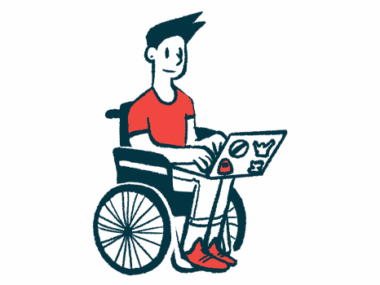Why I decided to adapt to life with scoliosis instead of having surgery
While everyone is unique, for me, spinal fusion surgery was too risky
Written by |

Being diagnosed with a progressive neuromuscular condition like spinal muscular atrophy (SMA) often brings a range of physical challenges that significantly impact both the people with the disease and their loved ones. One of these challenges is scoliosis.
According to the American Association of Neurological Surgeons, scoliosis is a common condition affecting up to an estimated 9 million people in the United States. It causes an “abnormal lateral curvature of the spine” and can vary in severity.
Living with severe muscle weakness due to SMA is already challenging, but scoliosis adds another layer of difficulty. I endure chronic back pain as my spine curves into a severe C shape, which is particularly debilitating. While most people develop scoliosis during childhood or early adolescence, it can appear much earlier. In my case, it became a prominent issue 25 years ago, around the age of 3.
Finding workarounds
When I was growing up in the late 1990s and early 2000s, wheelchairs didn’t have the advanced features they do today. Unlike today’s more comfortable options, they had a single recline option and uncomfortable, rock-hard cushions. Because of this, I frequently had to skip family gatherings or leave early, as back and butt pain would leave me in tears after just 20 minutes.
My mother always found creative ways to keep me comfortable while ensuring I had a wonderful childhood. During summer barbecues and birthday parties, she’d cover my shower chair with a soft sheet or blanket so I could enjoy the event without rushing back home. Once, when she took my sister and me to the circus, she brought an adjustable beach chair, allowing me to enjoy the show without agony.
When I began attending school in Brooklyn, New York, nearly an hour from my home in Harlem, I depended on nonemergency ambulance services for my daily commute. The hourlong trip in my standard wheelchair was unbearable. Upon arriving at school, I would transfer to my Tumble Form chair, where I stayed until the ambulance drivers returned to take me home at the end of the school day.
As I grew older, my appointments with an orthopedic specialist became more frequent. Every six months, I had X-rays to monitor the progression of my spinal curvature. I dreaded these appointments because I had to endure uncomfortable positions for the in-depth imaging, leaving my body sore. Additionally, they often involved difficult conversations about the possibility of surgery, which added to my apprehension. I was not open to the idea of going through a procedure that involved so much pain and a lengthy recovery period.
Around my 17th birthday, my parents and I had a final discussion with a spinal surgeon about the pros and cons of undergoing spinal surgery. Initially, we considered VEPTR rods (which stands for “vertical expandable prosthetic titanium ribs”) because the procedure is less invasive than spinal fusion. Unfortunately, I didn’t meet the eligibility criteria for the VEPTR option, leaving spinal fusion as the only other choice.
After thorough consideration, my family, the spinal surgeon, and I agreed that the risks of spinal fusion far outweighed the benefits. Even the surgeon expressed unease with performing the procedure on me, noting again that it would be a lengthy and painful process. Additionally, due to the severity of my curvature, I would need to undergo more than one surgical procedure to straighten my spine completely, and the surgeon mentioned that the chance of survival was “very slim.” After that appointment, I felt a great sense of relief.
This discussion, and our collective decision to forgo surgery, marked the end of my reoccurring appointments with the orthopedic doctor, the horrifying discussions about surgery, and the unenjoyable series of X-rays every few months. My curvature was already at its worst, but it wasn’t impeding my health.
For the most part, I’ve been living and thriving with my scoliosis, experiencing minimal complications thanks to the support of a ventilator for my breathing. My curved back enhances my natural curves, helping to boost my self-esteem.
On the other hand, I have developed hip dysplasia, a condition that causes the hip socket to become wholly or partially dislocated, which contributes to my chronic pain. However, the condition isn’t severe enough for me to consider getting hip surgery. I manage my pain with a mixture of medication and massage therapy.
Living with SMA, scoliosis, and hip dysplasia makes life incredibly complex. Choosing what is worth putting yourself through while living with debilitating physical impairments is imperative when seeking treatment from medical professionals. I raised my concerns throughout my various orthopedic appointments. While I understood that either choice would affect everyone around me, my decision not to go through with such a challenging procedure was received with understanding and acceptance by my family and the team of doctors who followed me through the decision-making process.
Note: SMA News Today is strictly a news and information website about the disease. It does not provide medical advice, diagnosis, or treatment. This content is not a substitute for professional medical advice, diagnosis, or treatment. Always seek the advice of your physician or other qualified health provider with any questions you may have regarding a medical condition. Never disregard professional medical advice or delay in seeking it because of something you have read on this website. The opinions expressed in this column are not those of SMA News Today or its parent company, Bionews, and are intended to spark discussion about issues pertaining to spinal muscular atrophy.








J P Haldane
Had the surgery at 41 and wish I had done it earlier. Much easier these days. The doctors say no known cause but when identical twins have it (2 males and 2 females) there must be some genetic trait. They just have not identified it yet. Weak muscles perhaps.
Nick Smit
Wow. What a journey you have been through. Thank you for sharing what you went through.
Susana Morse
Hi Jasmine :-) your story echoed many of my own experiences. Have you ever considered acupuncture? I added traditional Chinese medicine to my toolkit years ago and have been surprised at how much it helped. It’s effective with pain management, inflammation, bladder & bowel health and even hormonal imbalances. Your mileage may vary but it’s something to consider
Jasmine Ramos
Hi Susana, Thank you so much for your comment! I'm glad you could relate to my writing piece. I've heard many great things about acupuncture, but as someone who is extremely afraid of needles, I haven't been brave enough to give it a try.